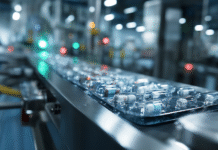Abstract – Basically, increasing the thickness of film materials is one of the important measures to improve the barrier properties of packages. Meanwhile, the increase of materials thickness is bound to increase packaging costs. This article studied the influence of increasing the thickness of single-layer membrane in composite materials and the effect of barrier properties on packages.
Barrier performance is one of the basic properties of packaging materials to protect the content products. The barrier properties of packaging materials are related to materials structure, thickness, and other factors. For the same film materials, when the thickness is increased the barrier properties are improved. The composite materials are most used for plastic packaging. By combining different types of single-layer films, composite materials can make full use of the advantage of different materials to meet the packaging requirements.
Since they play different roles in packaging structure, the influence of increasing thickness of different layers is also different on improving the packaging permeability. Therefore, blindly increasing the thickness of the packaging material may not achieve the expected barrier properties, but seriously increase the costs. In this study, we tested the oxygen permeability of films materials with different thickness, and then analyzed the influence of increasing the thickness of different layers on the barrier properties of packages.
We used PET(12μm)/PE(45μm),PET(12μm)/PE(60μm),and PET(25μm)/PE(45μm) with different thickness as specimens for this study, and tested their oxygen transmission rate. We used the differential pressure method to test according to ASTM D1434 – Standard Test Method for Determining Gas Permeability Characteristics of Plastic Film and Sheeting. The equipment used is VAC-V2 Gas Permeability Tester, provided by Labthink Instruments. In principle, the oxygen transmission rate is the quantity of oxygen passing through a unit of plastic film in unit time under stated temperature and gas pressure on both sides of the films.
Specimen # Specimen Thickness OTR
1 PET(12μm)/PE(45μm) 106.297 cm3/(m2/24h/0.1MPa)
2 PET(12μm)/PE(60μm) 87.406 m3/(m2/24h/0.1MPa)
3 PET(25μm)/PE(45μm) 45.617 m3/(m2/24h/0.1MPa)
Conclusion
Compared with Specimen #1, the oxygen transmission rate of specimen #2 & 3 both decreased because of the thickness increase of PET or PE. The OTR of specimen #2 reduced by 18.891 cm3/(m2?24h?0.1MPa) with a 15μm increase in the thickness of PE layer, while the OTR of specimen #3 reduced by 60.680 cm3/(m2?24h?0.1MPa) with a 13μm increase in the thickness of PET layer. This indicates that the PET layer bears the main oxygen barrier effect in the test materials, and increasing the thickness of PET layer is more conducive to improving the oxygen permeability performance of the materials.
The equipment used in this test has three test cells and we can obtain the test results of these three specimens in one test. The test efficiency was very high. Labthink Instruments is dedicated to providing integrated professional quality control solutions for packaging manufacturers, food and beverage producers, medical and pharmaceutical companies, and various chemical and printing industries. Its Greater Boston headquarters combines functions of the North America sales division, the R&D center, the packaging testing laboratory, and the customer services center and administration.












